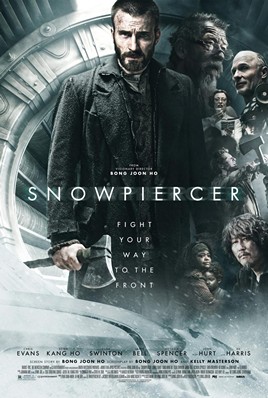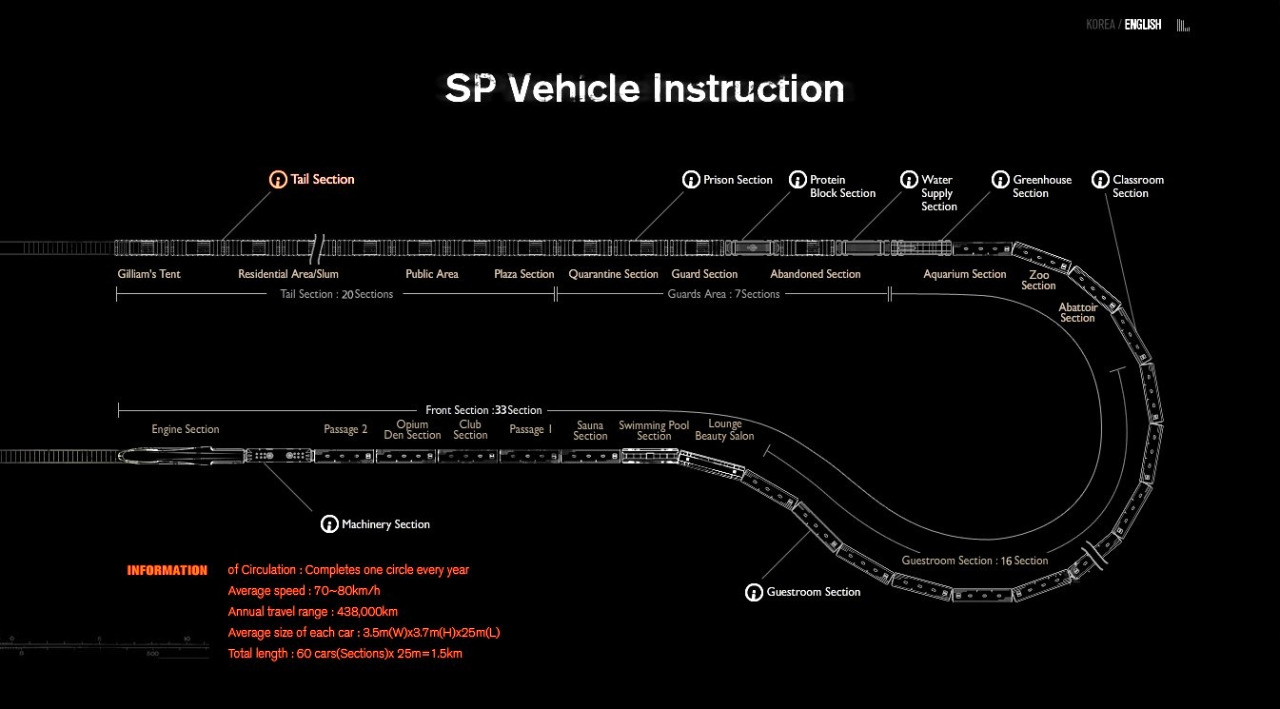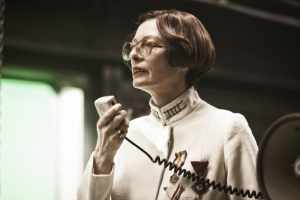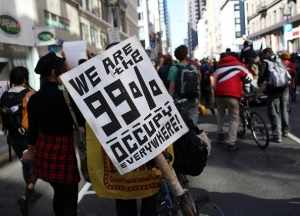Snowpiercer and Social Revolution

The film Snowpiercer (2013) is, on the surface, a very weird scenario. The earth is plunged into a new ice age, due to the measures to slow global warming, rendering it inhospitable. The last safe haven is a train perpetually travelling across the surface of the earth, where the occupants live in either luxury or squalor, becoming metaphorically of our own world. However, this rather surreal film has something to say about contemporary society, and social, political, and economic structures the world lives by. Specifically, the film is critiquing the problems in the class system, and how it is inherently unjust. This is seen within the film via the setting, in how the different sections of train are set out, the power positions of the characters, and what these positions might suggest or symbolise, as well as the revolutionary events of the film. As well as this, the theory of Marxism can be used to examine the film, and what its position on class is.
The Train

The setting, called ‘The Rattling Ark’ in the opening titles, but simply referred to as ‘The Train’ in the movie, acts as a microcosm for the world. Which is to say, with the whole population compressed to nothing but this train, therefore it symbolises the structures of the entire world.
The train is approximately sixty sections long – according to the concept art – and throughout the narrative, we progress from the very back, ‘the tail’, to the very front. The tail section is essentially a slum, the inhabitants never having any real food, just gelatinous masses called ‘protein blocks’, no access to sanitation or medication, and no hope of escape.
This area is clearly symbolic of the lower classes of the world, more specially relating to the slums in the third world. The film is highlighting how global society knows these places exist, but do not do anything to stop it. At one point a minor character refers to those at the back of the train as “freeloaders”, perhaps showing how those who are better off look down on those who cannot get by in the world, despite their inability to feed or help themselves. As well as this, these inhabitants of the train are heavily guarded, showing how contemporary society, or a conservative one, does not wish for those at the bottom to make any social progression.
After a guard station, we come to the prison. In terms of the layout this is ironic, as this section is further up the train, showing how a criminal from the upper classes is seen as to have more inherent value than someone living in a slum. This also implies that the criminals are kept in conditions a little better than that of the tail section. The guards’ living area is further up, which has windows, showing the benefits of being a little higher up in society. The guards, as well as anyone else who has a job working for the train, can be considered as part of a working class, showing another part of the social order in contemporary society. Next comes the food production for the lower class of people, where we see one man, who has been taken from the slums, and is charged with making their food. Again, showing that because he performs a service, society views him a little higher. After this there are empty cars, this possibly shows the divide in the classes, and how there is a great distance between the rich and the poor.
This, arguably, marks the beginning of the more affluent part of the train. The next section is the water supply, perhaps seen as too important to reside in the lower half of the train, followed by three sections of food supply for the upper classes. An orchard/garden, an aquarium, and an abattoir. This shows how the rich can afford to eat better, while the poor are left with food that always leave them hungry or under nourished. Following this is a classroom, where the children of the front section are educated, and also indoctrinated into the belief’s of the train. They sing a nursery rhyme that goes: “What happens if the engine stops? We all freeze and die.” The young children singing this is quite chilling, and it shows how the upper classes in contemporary society teach their young to believe in the social order from a very young age.
Further on, we pass several carriages where the residents of the front live. These sections include a Tailor’s and a Dentist, which perhaps shows another rank in the social structure in contemporary society, as these jobs represent the middle classes, and a more comfortable style of living.Further along is a high-class restaurant, salon, pool and sauna, and finally a nightclub and drug den. This is particularly symbolic, as while those at the back starve, those at the front party and do drugs. Finally we come to the front of the train, which is what pulls it along, via a perpetual motion machine. This symbolises the perpetual motion of contemporary society, and how what goes on within it will not cease to exist until the very structure is destroyed. Thus, it is evident how the setting of the movie symbolises the class structures within society, and how this implies things about our world without even looking at plot or characters within the film.
The People

This class-orientated society is epitomised by the people who inhabit it, and they represent real world figures or organisations within our own society. Firstly, Tilda Swinton’s character ‘Mason’ could be considered symbolic of the concept of ideology, which is the system of ideas or beliefs that form political and economic structures of society. This Marxist term can mean a great many things, like political propaganda, religious doctrine, or media perceptions. This could also be seen in the aforementioned scene within the classroom, and the young children parroting the morals of the train.
The characters androgyny clearly highlights this link to a multitude of ideals. Mason is referred to as both ‘Sir’ and a ‘bitch’ within the film. The actress commented herself that she does not known “what Mason is” is terms of gender, thus showing the character to represent various forms of belief. The link to Ideology is also seen through the characters dialogue, Mason often refers to Wilfred, the head of the train, as ‘benevolent’, a common religious piece of terminology, as well as political nuances in her speeches concerning social order. However, Mason is spineless, as when threatened (s)he changes sides easily, showing that the film believes ideology, although the underpinning of society, can be manipulated easily if one chooses to do so.
The aforementioned character of Wilfred is also key to the film, as he is the head of the train, and this could be equated to the real life head of state. He is only seen in the engine room of the train, and can therefore be closely related to the ideas of the perpetual motion machine, and that the head of state is what keeps in the machine running. He tells Curtis – the protagonist – that “everyone has their allotted place” showing that he does not believe in societal change, and like contemporary society, he does not take strides to liberating the hungry at the expense of the pleasure of the rich. This also places him as a conservative character, therefore asserting the film as a more liberal one. As well as this, Gillian, the leader of the tail (played by John Hurt) can be linked to this idea, as although he strives to break free of the tail, he is actually in constant contact with Wilfred, and manipulates the events of the movie on his instructions. This show the power of the head of state, as well as indicating that the two ends of the train are not so simply pitted against each other.
The protagonist – Curtis (played by Chris Evans) – represents the Marxist revolutionary. In the communist manifesto, Karl Marx and Friedrich Engels wrote about the divide between the proletariat – in this case the tail – and the bourgeoisie, the front. Curtis represents both class oppression, as well as breaking out of class boundaries, as he is the only one to have ever traveled from one end of the train to the other, thus showing how he has broken these boundaries. As well as this, the monologue the character gives before entering the engine room, where he talks about the early years of the train and how the residents of the tail were forced into cannibalism, and how he knows that “babies taste best” shows the distinct class oppression embodied in this character as he has been forced to commit what many think is the worst human act.
The Revolution

The events of the film mirror a class revolution. The inhabitants of the ‘tail section’ of the train force their way to the front, in a similar way to the poor of a contemporary nation rising against the wealthy upper class. Their purposes are also identical, with the revolution in the movie, and the parallel class revolutions of our society both wanting to gain a more equal distribution of wealth and resources.
As previously mentioned, the film can be related to the theory of Marxism, and the protagonist, Curtis, the main instigator of the revolution, can be viewed as the epitome of the marxist revolutionary. He is acting not for the good of himself, but for the good of his class, and even when offered a position at the head of the train at the climax of the film, he turns it down, refusing to abandon his principles.
Furthermore, on the revolt making its way to the upper part of the train, the residents of this section also revolt, and try to kill their would-be usurpers. This symbolises the class aggression on the part of the upper classes, as well as a conservative ideology. They do want to be dethroned, nor do they strive for a better system of living, as they are the ones who benefit most from the current system. Again, this mirrors the reluctance of the wealthy elite of contemporary society to implicate a system where the economic wealth is more evenly distributed. This film was made not long after the Occupy Movement, a group that campaigns against the global economic inequality, and the film is clearly allegorical of these ideals. However, the effects of this movement remain to be seen, as there are not real world effects of the process beyond somewhat beginning a dialogue on the subject.
However, it turns out that the initial revolution, as well as the previously mentioned attempts at revolt in the past, have been instigated by Wilfred, the head of the train. He is able to communicate with Gillian, who willingly manipulates Curtis, as well as the entire tail section, into a state of revolt, on the orders of Wilfred, and he has previously done this in the aforementioned attempts at revolt. Wilfred uses these events as a way of keeping the population of the tail section in check, as well as to make sure the number or residents does not grow too large. Perhaps this parallels political debates within western society, as although each individual has freedom of vote, they do not have the power to make change on their own, and the masses are influences by those in strong positions of power within politics, religion, and the media.
The film however does not end in a victory of the revolution, nor a victory against it. Instead of reforming the society of the train and having everyone live in equality, the film’s characters trigger events which destroy it. Perhaps this is arguing that contemporary society is so stuck in the current system that it would take a massive societal upheaval so as to make any sort of change to the social order. The ending of the film is somewhat more hopeful, as although the train has been destroyed, the audience sees that two characters have survived, and possibly more within the wreckage, as wells the fact that life still exists on earth. Therefore humanity will be restored in some form or anther, and that this version of it is gone.
It is clear from analysing the film that it holds strong beliefs on the social structures of society, and that the current system that western society lives in is not working. Nor is global economics good from the wellbeing of the majority. Although the film is very good at expressing its qualms with this society, it does not know where it should actually go from here. But the revolutionary ethos of the film, which has been critically acclaimed, shows that within contemporary society there are those wishing to make change, and that this will happen with affirmative action.
What do you think? Leave a comment.











I haven’t seen it but it is surprising to see the chemtrail and geoengineering theme in a hollywood movie. Weather manipulation has been used for decades. There are many esoteric themes and possibly predictive programming events in Snowpiercer. Looking forward to seeing it.
Mankind’s tragedy is exemplified in this film. Long ages are spent in fighting a tyranny from which escape is impossible through our own efforts. It is as if we are trying to cut our way out through a tough transparent membrane with plastic picnic knives.
Found the movie to be entertaining and thought-provoking to be sure.
Thanks so much for writing about this movie. It is definitely a film I want to watch and will look out for and also I am a Chris Evans fan too.
I love this movie, so thanks for writing thought-provoking material on it. Hopefully this will encourage others to watch it. 🙂
I greatly enjoyed the movie, and it was nice to see an article that decided to take a critical approach to the film. I think some mention of the fact that they spotted an animal living on its own on the outside of the train would have been good to mention, just because of the ideology that was pushed all the way down the train – that the outside world is dead and uninhabitable. I think that fact adds to the upper class wanting to keep themselves in power over the lower class, or it could even indicate that everyone on the train was falsely informed about what the outside world was really like.
Fantastic article on a fantastic movie. I’ve studied a lot about Bong Joon-Ho in my Asian Cinema class this spring, with his other films like The Host and Mother. He’s a very dark and inventive storyteller, and I’m glad his style of Korean filmmaking carried over to Snowpiercer.
We never actually learn if Wilford was telling the truth about collaborating with Gilliam. He could have been simply trying to manipulate Curtis.
Mason seems to be a hyperbolic version of Margaret Thatcher.
the way I interpret it is that the two leaders (front and back) were wrong. There is life outside the train, and there might be humans left too.
I love this movie, the director is so brilliant..
The movie fails. There was simply no point to the tail section. What balance did the tail section serve?
The tail section served the purpose of recycling the insect population into fecal fertilizers… Protein blocks
The snowpiercer is a deep film….u need to have some unanswered questions existing in u about life before u can understand to a large extent the message pass by this film…the film takes a sequence of –balance–continuity–necessity of good and evil. The film ask u, how do u define evil when its essence is to contribute to growth and continuity. who are u, how do u make your choice, are u good, are u bad, what is your destiny…… there r no answers…. there is just u.
Deconstructing Snowpiercer without its cinematographic elements feels a little wooden and linear, though I understand it’s impossible to address everything in one article.
It is, however, an educational piece, not a film review, so where the article could use further exploration is brought up by Larae (comments above): whereas in the general Marxist understanding of society, the poor are the powerful, subservient backbone, capable of uprising and overthrowing, what use do the poor in the train serve? Largely dead weight.
Interesting movie, I’ll have to check it out.
Great job with this analysis.
Is anyone else confused by how the polar bear managed to find shelter and food for all of those years despite temperatures that would turn you into an ice cube within minutes?
Take it for what it is: an awesome sci-fi B movie with an absurd premise that happens to have some… interesting… political messages. My expectations were met.
Unpopular opinion time: I loved the ending *because* it shows that humans are going to go extinct, but life itself will go on (the polar bear). My original opinion was that the director was trying to say that human ideologies of order, no matter how complex and well thought out, will, ultimately, always crumble, but life itself is persistent beyond what humans can comprehend. We will never be above nature, or able to synthetically replicate its functions (long-term), and I think Minsoo was closest to understanding that. I thought it was absolutely beautiful. I’m almost disappointed Bong said otherwise, when there is clearly no way humans could survive in the situation he put them.
I think it’s a bit naive that everybody expects the two kids to just wander off into the snow and die. If you want to look at their situation logically, they still have shelter (the train) and several cars to rummage through for supplies–until they learn to cope with their new surroundings. It’s also ambiguous whether or not anybody else survived (which is very possible). The way I viewed the ending, was that they were stepping out because they simply never have before, and they were just ‘testing the waters,’ to see if the world was livable. They see the polar bear, and their question is answered.
Great article!
Bong Joon-ho tried to paint a hopeful picture for the restart of humanity.
Snowpiercer is a great film. I’m glad you had the idea to think about id more deeply. Great article!
I’m actually surprised how much this movie struck an emotional chord within me.
The crux of this film is an idea adapted from (I’d like to think) Le Guin’s “The Ones Who Walk Away from Omelas.” The society revolves around the sacrifice of two children, the question being, what is the cost of civilazation? A Marxist lens is certainly helpful, especially given the filmmaker’s own history as a South Korean, but I think understanding this intertextual reference is crucial to a deep and nuanced discussion of this film.
The movie is pure allegory intended to inspire dialog and prevent catastrophe.
You’ve done a good job at highlighting the overall thesis of the film. However, what I think made Snowpiercer so good was not so much what it was saying, but rather how they said it. That’s why it was so much better than Elysium (also released in August of 2013), which was also an exciting action sci-fi adventure with a similar class politics-driven plot. Unlike Elysium, Snowpiercer didn’t take itself too seriously, which allowed for a more satirical (and often very humourous) rendering of the same basic plot. The classroom scene is the epitome of what makes Snowpiercer so special, being the stark turning point after which it ceases to be simply a gritty action movie with politcal undertones and becomes an over-the-top parody of socioeconomic hierarchies and their governing ideologies.
Snowpiercer was a surprisingly good indie film and Chris Evan’s best work to date.
This is definitely a movie worth watching. It’s thought-provoking and possesses spectacular cinematographic qualities.
A good essay but a strange movie.
This movie was actually about strain theory and neo-colonization. Wilford creates “strain” between social classes to help control population. The tail serves functional purposes such as uprisings for pop. control and reserve labor force. Use some academic references if you want to be taken seriously. This is just a bunch of goop with no backup. I would consider this a movie review, not a sociological analysis.
It’s a little bit of this and a little bit of that.